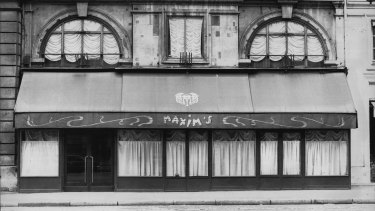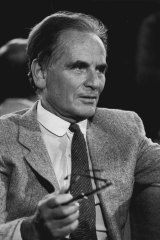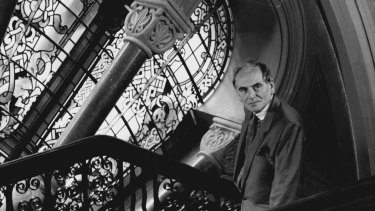From the Archives, 1987: Maxim’s – icon of La Belle Epoque
First published in The Age, June 20, 1987.
Lucky Pierre — but not at Maxim’s

AT 8 AM, Pierre Cardin awakens to trumpets. Across the street from his four-storey Paris townhouse, reveille is sounding at Elyse Palace, the residence of the President of France.
Moving with the agile grace of a dancer, the 64-year-old designer rises quickly, makes his bed and hurries down two flights of stairs for a cup of coffee prepared by his sister, Jeanine, who is 20 years his senior.
Within a few minutes, he has repaired to the ground-floor study lined with antique bookcases and seated himself behind a massive desk. There, like an old-fashioned notaire, he pores over the leather-bound ledgers that contain the accounts of his far-flung empire, checking them against the previous day’s fluctuations in the dollar, the yen, the mark. “I love to follow the exchange rates,” says Cardin, his gaunt face brightening. “It helps me understand my business.”
Eighty-five per cent of that business comes from 800 licensees in 93 countries who sell $1 billion a year wholesale in Cardin-labelled products, from clothing for both sexes to sheets, from clocks to deodorants. His take: between five and 12 per cent. This steady stream of income from the exploitation of a name synonymous with high fashion has earned him a sobriquet, the Napoleon of licensers. “I was born an artiste,” he declares proudly, “but I am a businessman.”
His accounts completed, Cardin sets out on his ritual march through his Right Bank neighborhood, a supremely elegant territory of embassies, four-star deluxe hotels and luxury shops. At the corner of Rue de l’Eysee and Rue du Faubourg St Honore, he glances to the left in the direction of a 19th-Century mansion. This is Pierre Cardin, maison de haute couture, well-spring of his fame and of his licensing empire.
Facing him across the Faubourg are a boutique called Maxim’s, its windows filled with glittery dresses and men’s evening suits, and, towards the right, a refined snack-bar-cum-gourmet food emporium — Maxim’s Minim’s. They are outposts of this Napoleon’s second licensing empire, and within a few blocks he reaches the historic monument that is its inspiration. There, at 3 Rue Royale, is Maxim’s restaurant, the mahogany doors capped by a scarlet awning lettered in gold. Cardin has sunk millions (“A big fortune of mine,” he says) into creating a global Maxim’s network ranging from clothing and food products to restaurants and hotels.
Cardin revels in his ownership of the Belle Epoque shrine he acquired six years ago. Ever the showman, he moves about the restaurant, his slender hands slicing the air, exulting in the Art Nouveau decor that has been Maxim’s hall-mark since its founding in 1893 — the brilliant stained-glass ceiling, the pre-Raphaelite murals of scantily clad nymphs. The words tumble forth at the breakneck speed of a Parisian. “Someone from Argentina who spends one night at this restaurant will never forget it,” he says.
Cardin became a celebrity in the 1960s, the era when fashion functioned as the engine of pop culture. He was of the avant-garde, a creator of sexy, space-age designs, yet it was his revival of the silhouette of the Edwardian dandy that made him the first couturier to become a major force in men’s fashion. And his love affair with Jeanne Moreau, the film star, added allure to bachelor Cardin’s reputation.
Now, Cardin is attempting to repeat his triumph, with a name other than his own and in businesses where he is a tyro. He has endured enough setbacks to discourage a lesser entrepreneur, but Cardin maintains his sang-froid. “In the next century, Maxim’s will exist,” he insists. “Who will know Yves Saint Laurent or Pierre Cardin?”
IN JANUARY 1977, Louis Vaudable, the suave restaurateur whose family had owned Maxim’s for more than four decades, invited Pierre Cardin to dinner. At the age of 74, Vaudable was worried about the future of the restaurant. He and his elegant wife, Maggy, had updated Maxim’s racy image, transforming it into a temple of haute cuisine as well as a hangout for international society.
Now, revenues were stagnant at $4.5 million a year, and its coveted, three-star ‘Michelin’ rating was endangered. He had already entered the catering business and had established restaurant franchises in Tokyo and Chicago. But Vaudable felt he needed the advice of the licensing impresario. And over scallop terrine and roast pheasant, he broached the topic: How could he cash in on Maxim’s glory?

Cardin was intrigued. Food was one licensing category he had never conquered. A Cardin brand of chocolates in a Plexiglas container had bombed. Perhaps he would succeed under another name. To the serenade of Maxim’s roving violinist, Cardin fabricated a grand licensing design — restaurants, of course, then hotels, evening clothes, perfumes. Cardin claims that Vaudable was “completely fascinated”. Shortly after, the two men signed an agreement evenly dividing Maxim’s future licensing royalties between them.
In the months after the dinner, Pierre Cardin indulged in uncharacteristic behavior. He has scrupulously avoided investing his own capital in the manufacture of products bearing the Cardin label, promising only to provide guidance in design. But now, to launch the “Maxim’s de Paris” licensing venture, he spent $4 million to purchase the leases for two stores on Faubourg St Honore, as showcases for Maxim’s products, and to pay legal fees to secure worldwide trademark rights.
In 1981, he bought out his partner for a reported $20 million. And six years later, 75 Maxim’s licensees around the world generate more than $30 million in annual wholesale revenues.
DRESSED IMPECCABLY in black tie, a purple silk foulard overflowing his breast pocket, Pierre Cardin stood with-in a reproduction of Maxim’s restaurant at the Metropolitan Museum of Art in New York. On this December evening in 1982, Andre Oliver, Cardin’s closest friend and collaborator for 35 years, was at his side.
There was much bowing and kissing in midair as 775 socialites — among them Pat Buckley, Nancy Kissinger, Betsy Bloomingdale, Jerry Zipkin, the ubiquitous escort, and designers Calvin Klein and Bill Blass – celebrated the premiere of the exhibition “La Belle Epoque”. Cardin had underwritten the show to the tune of $500,000.
“I wanted to re-create Maxim’s as a diplomatic gesture between France and the United States,” Cardin announced. “For me, La Belle Epoque is Maxim’s.”
The party was the New York salvo of a campaign to lay the groundwork for a worldwide chain of Maxim’s restaurants. In 1982 and ’83, Maxim’s restaurants opened in Beijing, London, Brussels and Rio de Janeiro.
THEIR FIRST meeting, in October 1983, was less than congenial. But then, more unlikely candidates for partnership than Pierre Cardin and Jack E. Pratt, chairman of Dallas-based Pratt Hotel Corporation, would be hard to find.
Cardin, the Parisian sophisticate, has a positive aversion to banks. “I don’t borrow,” he claims. “I build everything for myself day by day and step by step.” Pratt, a 59-year-old Sunbelt promoter, typically operates with other people’s money.
Pratt wanted to break out of the mass market into the rarefied niche of super-luxury with an international chain of hotels. Visions danced in his head of the Mansion, the inn for sybarites put up in Dallas by oil heiress Caroline Hunt Schoellkopf. He was shopping for a name to provide an instant recognition factor — something on the order of the Ritz. In fact, he had already investigated the possibility of licensing the Ritz name and had found the price tag too high. Then a Swiss merchant banker alerted Pratt to Maxim’s.
Licensees typically guarantee a minimum advance payment against a royalty fee of five to 10 per cent of gross revenues. Cardin wanted five to six per cent for the use of the Maxim’s name, but Pratt refused, and no deal was struck that day.
The Dallas promoter went on to sound out representatives of Yves Saint Laurent, Givenchy and Gucci, but nothing gelled. Seven months after their first meeting, he was back knocking on Cardin’s door, and this time the two worked out their differences. Cardin was to receive a $100,000 advance for each hotel against a royalty fee of 1.5 per cent of gross revenues.
The designer agreed to provide assistance with decorating and promotion, and would have the right to approve sites, decor and investors. “We need to know who handles our name,” says Herve Duquesnoy, who oversees Maxim’s licensing worldwide. “We don’t sign with gangsters.”
Over the next six months, Pratt and Cardin flew to Palm Springs, California, several times to inspect the progress of the first Maxim’s de Paris hotel.
Set against the San Jacinto Mountains and alongside a mall sprinkled with designer boutiques, the terraced, six-storey structure was being developed by Pratt and the Edward J. DeBartolo Corporation of Youngstown, Ohio, the nation’s largest shopping-centre builder. Pratt Hotel Corporation has a long-term management contract and a one-third equity stake in the hotel.
In December 1984, totally caught up in his Maxim’s adventure, Cardin signed a long-term lease on a six-storey building on Avenue Gabriel, close by Elyse Palace and the American embassy, and proceeded to tear it apart.
Not content to see Maxim’s name on the Pratt hotels, Cardin was determined to build his own monument, La Residence Maxim’s de Paris. “I wanted to give new meaning, new definition to luxury,” he says.
Over the next 18 months, Cardin poured some $14 million into lavish renovations. Ankles splattered with cement, he personally helped the workmen paint, tile and carpet the 39 suites and chose the location for every electrical outlet. La Residence would be his “laboratory for ideas”, a phrase French designers invariably use to describe their money-losing couture operations.
La Residence is an extravagance of styles, ranging from Louis XV to intergalactic. It may be the world’s most expensive hotel. Guests who prefer the ambience of a chateau may stay in the Suite Royale, a $7500-a-night duplex furnished with gilded 18th-Century antiques. The rooms on the top floor resemble the interior of a spaceship with brightly lacquered walls and geometric furniture.

PIERRE CARDIN WAS born near Venice in 1922, the son of a wine merchant, and at the age of two moved with his family to Avignon, France. As a teenager, he aspired to be a dancer or an actor but ended up spending World War II in Vichy, the capital of unoccupied France, apprenticed to a tailor.
Later, he worked in the administrative department of the Red Cross, where he picked up his accounting skill. After the liberation, he made his way to Paris and took jobs with the great couture houses of Paquin, Schiaparelli and Dior.
In 1950 he founded the House of Cardin and within a decade had attracted a superchic clientele.
IN SEPTEMBER 1985, CARDIN popped up in New York for the opening of Maxim’s restaurant, two years and $10 million of his own money in the making. Aficionados of haute cuisine were unimpressed.
Bryan Miller, restaurant critic for ‘The New York Times’, wrote that “this Belle Epoque icon of excess . . . is saddled with a vast and overreaching menu of classic French cuisine that makes consistency difficult”. The menu was changed twice, but the restaurant posted a $300,000 loss the first year, according to Monty Zullo, the manager.
Meanwhile, management problems forced the scuttling of Maxim’s restaurants in Brussels and Rio de Janeiro, and the fledging hotel venture was having growing pains.
Cardin had jetted in for the Hollywood-style opening of the Palm Springs hotel in February 1986, working the crowd of celebrities, including Zsa Gabor, Esther Williams and the late Liberace. But the party was soon over
Occupancy rates have failed to meet projections. Industry analysts and executives point the finger squarely at Pratt’s organisation. “Pratt is a middle-market management company with no experience at the top end of the market,” says a veteran hotel executive. There is also a problem with the Maxim’s name. “Marketing muscle is what you’re paying for as a licensee,” notes the same executive, “but you don’t get that with Maxim’s. The public has no perception of what it is.”
According to licensing experts, including Pierre Cardin, the success of the hotels and restaurants is crucial to establishing a Maxim’s brand for products. (“They are like the haute couture,” he says. “They bring an image, and people recognise the name more easily.”) But Cardin pushed Maxim’s into products before it had developed a powerful enough image.
In the United States, American Cyanamid introduced a Maxim’s perfume in department stores in 1985; it is now selling at J. C. Penney. Unlike the television ads for Calvin Klein’s Obsession, which broke at the same time, the Maxim’s commercials had neither a memorable visual image nor a meaningful slogan.
(By way of contrast, Pierre Cardin’s men’s cologne, brought out almost 20 years ago, still generates some $30 million in annual revenues worldwide.)
FOR ALL the Maxim’s uncertainties, the Pierre Cardin licensing empire continues to flourish.
Saint Bris, the director of licensing, estimates that the business is still expanding at a rate of more than 20 per cent a year. Cardin’s biggest new licensee is the Soviet Union’s Ministry of Light Industry. The deal, facilitated by Raisa Gorbachev after she saw his collection in Paris, calls for Cardin to provide 100 designs for men’s, women’s and children’s wear annually for five years, all to be manufactured in the Soviet Union from local fabrics.
The United States is Cardin’s largest market; in the past decade, retail sales of his licensed products in this country have skyrocketed from $250 million to $500 million. Apparel accounts for 30 per cent of that total.
Most Viewed in Business
Source: Thanks smh.com